Alabama, often called the “Heart of Dixie,” embodies the deep rhythms of the American South. It is a state where stories of struggle, creativity, and resilience have shaped both local identity and national history. From the cotton fields of the Black Belt to the vibrant streets of Birmingham, from the tranquil Gulf shores to the rolling Appalachian foothills, Alabama offers a landscape as diverse as its culture.
Few states carry such a profound dual legacy. On one hand, Alabama bears the scars of slavery, segregation, and the long fight for civil rights. Cities like Montgomery, Selma, and Birmingham became epicentres of the movement that reshaped America, their streets echoing with marches and voices demanding justice. Today, museums, memorials, and preserved sites ensure that these lessons of courage remain part of the state’s living memory.
On the other hand, Alabama is also a cradle of creativity and innovation. Muscle Shoals put the state on the global music map, drawing artists from around the world to its legendary recording studios. Huntsville, nicknamed the “Rocket City,” launched America into space, blending Southern charm with high-tech ambition. Rural towns like Monroeville inspired literary classics, while coastal communities like Mobile gave the nation its first Mardi Gras.
Nature, too, plays a starring role. The wild beauty of Little River Canyon, the heights of Cheaha Mountain, the soft sands of Gulf Shores, and the bird-rich wetlands of Dauphin Island make Alabama a paradise for outdoor exploration. Add to this the warmth of Southern hospitality, the spice of Gulf Coast seafood, and the comfort of barbecue and biscuits, and Alabama becomes more than a place to visit—it becomes a place to feel.
Alabama’s magic lies in its contrasts: past and present, sorrow and triumph, tradition and innovation. It is a state that invites discovery and rewards it with depth, character, and unforgettable stories.
Birmingham
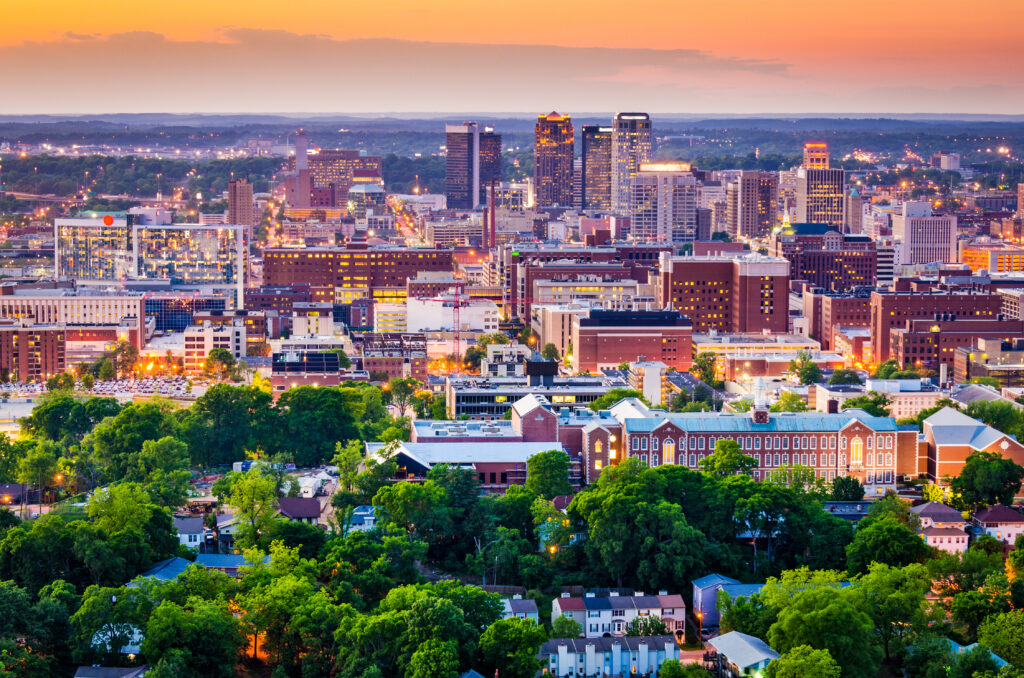
Known as the “Magic City,” Birmingham grew rapidly in the late 19th century as an industrial powerhouse built on iron and steel. While its smokestacks once defined the skyline, today it is remembered most profoundly for its role in the Civil Rights Movement.
The Birmingham Civil Rights District remains one of the most powerful historic areas in the South. The 16th Street Baptist Church, site of a tragic 1963 bombing that killed four young girls, and Kelly Ingram Park, where demonstrators were met with fire hoses and police dogs, are stark reminders of the fight for justice.
The Birmingham Civil Rights Institute ties these stories together, preserving the voices and struggles that reshaped America. Yet Birmingham is also a city of reinvention. Vulcan Park, crowned by the massive cast-iron Vulcan statue, offers sweeping city views and celebrates Birmingham’s industrial heritage.
Today, revitalized districts hum with craft breweries, award-winning restaurants, and art galleries. Birmingham balances solemn remembrance with cultural dynamism, making it one of Alabama’s most compelling destinations.
Montgomery

As Alabama’s capital, Montgomery is a city where multiple chapters of American history converge. It was here that Jefferson Davis was sworn in as the president of the Confederacy, marking its role in Civil War history. Nearly a century later, Montgomery became a cradle of the Civil Rights Movement. The Rosa Parks Museum recounts the courageous act that sparked the Montgomery Bus Boycott, while the Dexter Avenue King Memorial Baptist Church, where Dr. Martin Luther King Jr. preached, sits within sight of the Alabama State Capitol.
The Civil Rights Memorial, designed by Maya Lin, honors those who lost their lives in the struggle. Montgomery continues to expand on this legacy with the Legacy Museum and the National Memorial for Peace and Justice, groundbreaking spaces that confront the history of slavery and racial injustice. Alongside these powerful memorials, Montgomery has embraced renewal, with its Riverfront Park, arts district, and lively cultural scene ensuring that it is not just a city of history, but one of creativity and progress.
Selma

Selma is a small city with global significance, forever tied to the struggle for voting rights in the 1960s. It was from Selma that marchers set out on the historic Selma-to-Montgomery March, demanding equal rights under the law.
Crossing the Edmund Pettus Bridge, visitors trace the footsteps of those who faced violence on “Bloody Sunday,” when peaceful demonstrators were attacked by state troopers. This moment shocked the nation and helped lead to the Voting Rights Act of 1965. Today, the bridge stands as both a physical and symbolic landmark of courage and progress.
The Selma Interpretive Center and the National Voting Rights Museum keep this history alive, educating new generations about the sacrifices made here. Beyond its role in history, Selma remains a town with Southern charm, lined with historic homes and churches. To walk its streets and especially to stand on the bridge is to feel both the pain and the power of a moment that changed America forever.
Tuskegee
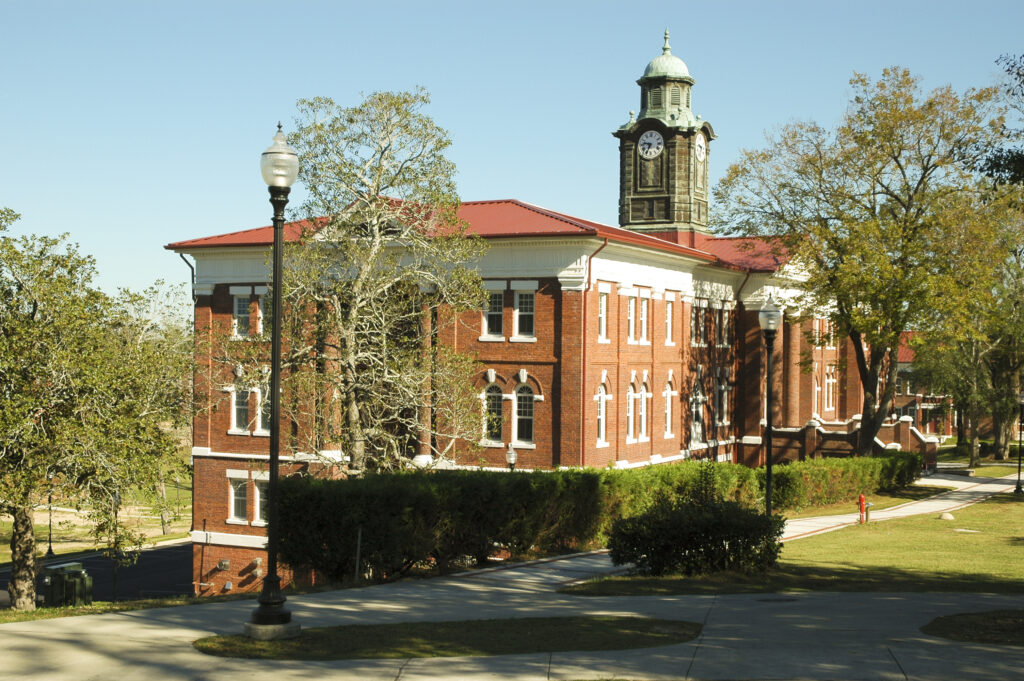
The small town of Tuskegee carries immense national importance, woven into both African American education and military history. Tuskegee University, founded by Booker T. Washington in 1881, became a beacon of opportunity in the segregated South. Here, George Washington Carver conducted his pioneering agricultural research, transforming farming across the country.
Nearby, the Tuskegee Airmen National Historic Site preserves the legacy of the first African American fighter pilots in the U.S. military, who flew bravely during World War II despite facing discrimination at home. Their success in combat shattered stereotypes and paved the way for desegregation in the armed forces.
Tuskegee itself remains a small community, but its contributions to education, science, and civil rights resonate far beyond Alabama. It stands as a reminder of resilience and leadership in the face of hardship.
Huntsville
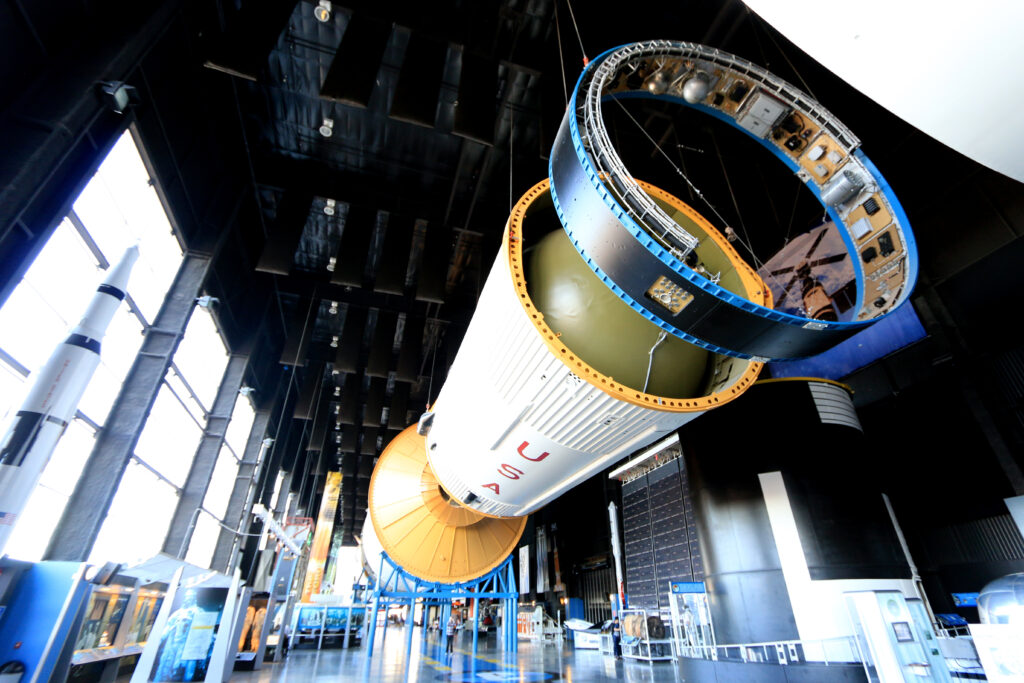
Known as the “Rocket City”, Huntsville transformed from a quiet Southern town into the center of America’s space ambitions. It was here that Wernher von Braun and his team developed the rockets that carried astronauts to the moon.
The U.S. Space & Rocket Center remains a world-class attraction, home to a Saturn V rocket and immersive exhibits on space exploration. For many, it is a thrilling introduction to NASA’s achievements and Huntsville’s role in shaping them. Yet Huntsville is more than rockets.
Its Twickenham Historic District showcases elegant antebellum homes, while Lowe Mill Arts & Entertainment, housed in a former textile mill, is the largest privately owned arts facility in the United States. Nature lovers will find Monte Sano State Park just outside town, offering hiking trails and scenic overlooks. Huntsville blends innovation and tradition, symbolizing Alabama’s ability to embrace both heritage and the future.
Muscle Shoals

Often called the “Hit Recording Capital of the World”, Muscle Shoals is a small city with an outsized impact on music history. In the 1960s and 70s, its modest studios produced songs that defined soul, rock, and R&B. FAME Studios and Muscle Shoals Sound Studio drew artists like Aretha Franklin, Wilson Pickett, The Rolling Stones, and Lynyrd Skynyrd.
The legendary “Muscle Shoals Sound” emerged here—a gritty, soulful blend that changed popular music. Today, visitors can tour these historic studios, where instruments and recording booths remain preserved as if the artists had just stepped out.
Beyond its musical fame, the area offers natural beauty along the Tennessee River, with opportunities for boating and fishing. The story of Muscle Shoals is one of creativity rooted in community, where a small Alabama town captured the rhythms of the world.
Mobile
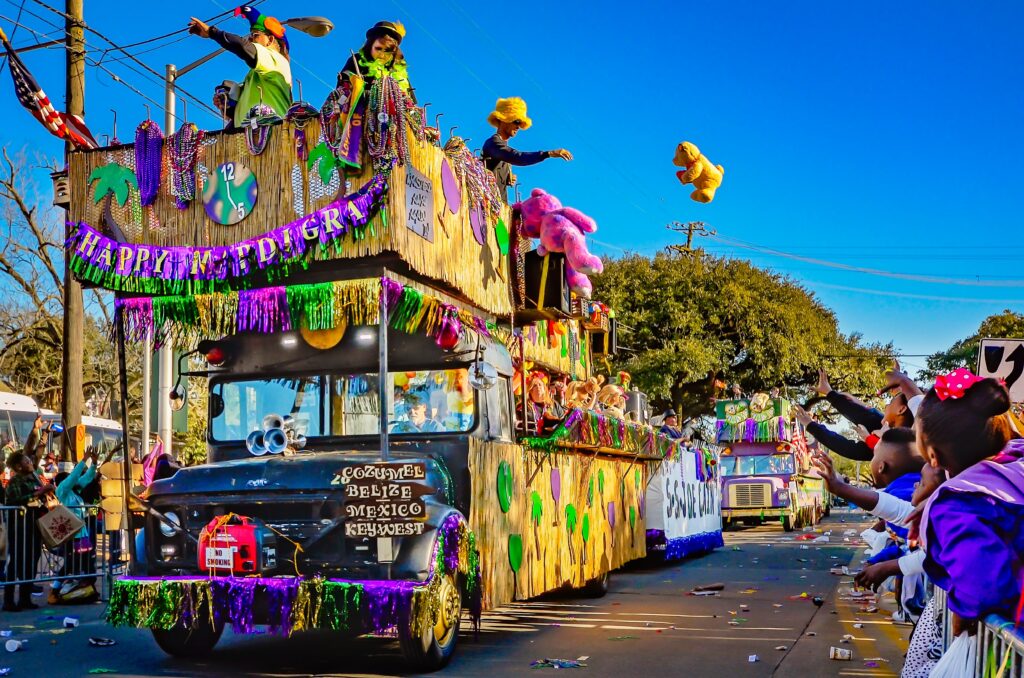
Founded in 1702, Mobile is Alabama’s oldest city and one of its most culturally rich. With French, Spanish, British, and American influences layered into its history, Mobile feels more like New Orleans than any other city in the state. It is the birthplace of Mardi Gras in America, celebrated since 1703, with dazzling parades, elaborate floats, and festive balls filling the city each spring.
The USS Alabama Battleship Memorial Park offers an impressive glimpse into naval history, with a WWII battleship, submarine, and aircraft on display. Mobile’s historic districts, lined with live oaks draped in Spanish moss, showcase beautiful antebellum homes and colonial architecture.
On the waterfront, the Gulf Coast Exploreum Science Center and vibrant downtown add to the city’s appeal. With its blend of history, celebration, and coastal charm, Mobile stands as one of Alabama’s most dynamic cities.
Gulf Shores & Orange Beach

Gulf Shores and Orange Beach are Alabama’s crown jewels on the Gulf of Mexico, renowned for their sugar-white sand and turquoise waters. This stretch of coast is a haven for beach lovers, offering miles of shoreline perfect for swimming, sunbathing, and water sports.
The Gulf State Park features hiking and biking trails, as well as a long fishing pier that extends into the Gulf. Families flock here for dolphin cruises, sailing trips, and fresh seafood dining, while adventurers can try parasailing or deep-sea fishing.
Festivals such as the Hangout Music Festival bring international crowds, while quieter moments can be found along nature trails or at sunset over the water. With a relaxed yet vibrant atmosphere, Gulf Shores and Orange Beach are quintessential beach escapes that prove Alabama’s coastline is as alluring as Florida’s or Louisiana’s.
Dauphin Island

Just off the coast, Dauphin Island offers a more tranquil seaside experience. Known as the “Sunset Capital of Alabama,” the island boasts breathtaking views as the sun dips into the Gulf. Rich in history, it is home to Fort Gaines, a well-preserved Civil War fort that witnessed the Battle of Mobile Bay.
Nature is equally prominent here: the Audubon Bird Sanctuary draws birdwatchers during migratory seasons, while beaches and salt marshes provide quiet retreats. A ferry connects the island to Gulf Shores, making it part of a broader coastal adventure.
Dauphin Island embodies a slower pace of life, where the history of coastal defenses and the serenity of nature blend harmoniously. It is a place to reflect, unwind, and experience the Gulf Coast as it was before mass tourism.
Little River Canyon
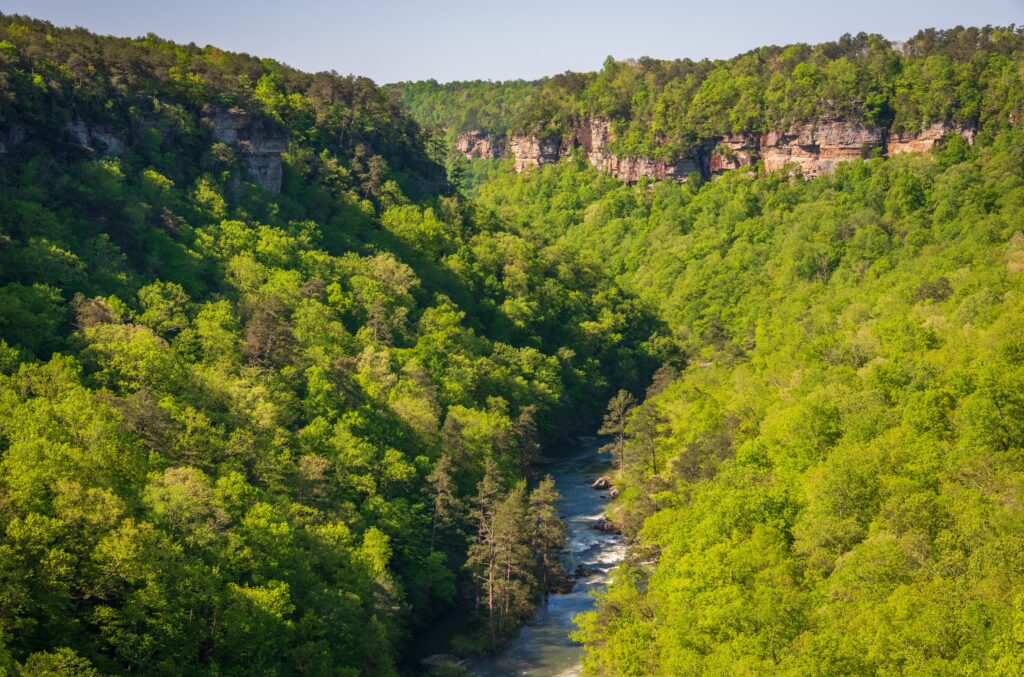
Located in northeast Alabama, Little River Canyon National Preserve is often described as the state’s most breathtaking natural wonder. Carved by the Little River, one of the nation’s longest mountaintop rivers, the canyon plunges more than 600 feet deep, offering dramatic cliffs and stunning vistas. The Little River Falls mark the entrance to the canyon, where visitors can picnic and swim in the natural pools.
Scenic drives along the rim provide spectacular overlooks, while hiking trails descend into the canyon itself, revealing diverse ecosystems and wildlife. For thrill-seekers, the river is popular for kayaking and whitewater rafting, depending on water levels.
Little River Canyon is both wild and accessible, making it a haven for adventurers and nature lovers alike. It stands as a reminder that Alabama’s landscapes rival those of any other Southern state in beauty and grandeur.
Cheaha Mountain

At 2,407 feet, Cheaha Mountain is the highest point in Alabama, offering breathtaking views from its perch in the Talladega National Forest. The name “Cheaha” comes from a Creek Indian word meaning “high place,” and it lives up to its name with sweeping vistas of forested ridges and valleys.
The Cheaha State Park, established in 1933, provides hiking trails, camping sites, and scenic overlooks like Bald Rock and Pulpit Rock, both easily accessible and offering some of the most iconic views in the state. Beyond hiking, the park features a stone observation tower built by the Civilian Conservation Corps, reminding visitors of the mountain’s role during the New Deal era.
Cheaha is not just a place for outdoor recreation but also a site of spiritual renewal, where visitors often find tranquility in its rugged beauty. For many, it represents the very peak of Alabama—literally and symbolically.
Noccalula Falls
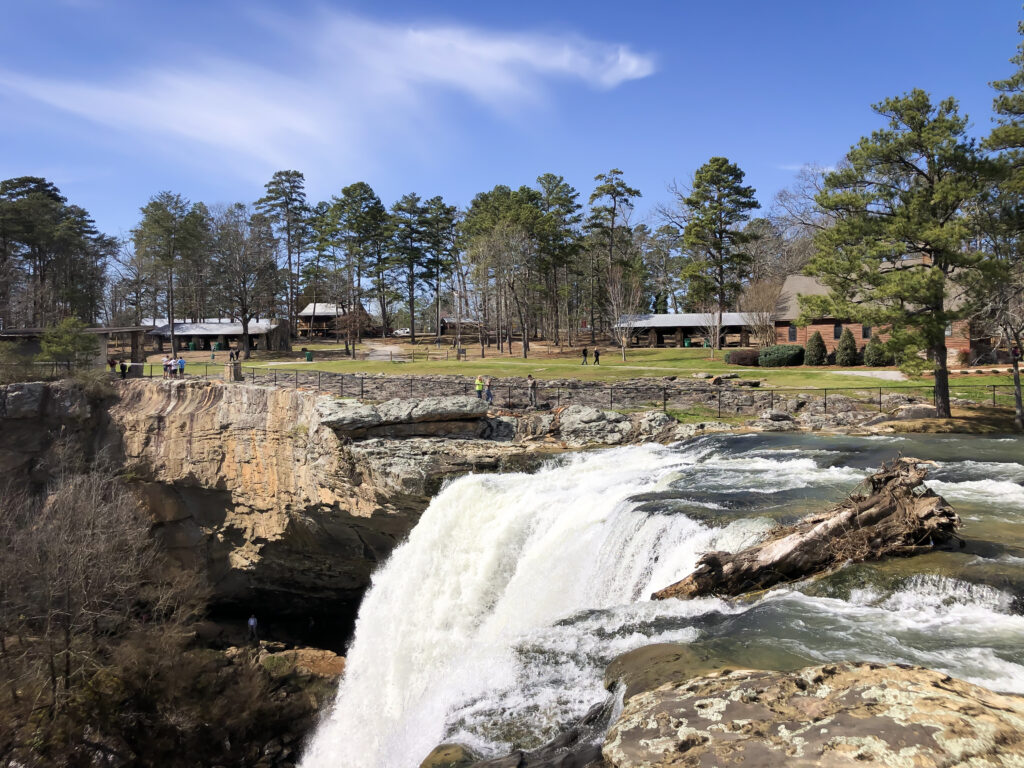
Noccalula Falls Park, located in Gadsden, is home to one of Alabama’s most striking natural attractions: a 90-foot waterfall plunging into a lush gorge. According to legend, a Cherokee princess named Noccalula leapt to her death here rather than marry against her will, a tale that gives the falls a sense of romance and tragedy.
Today, the park includes walking trails, botanical gardens, and a pioneer village that recreates 19th-century frontier life. Visitors can walk behind the cascade of the waterfall, offering a rare perspective of its raw power and beauty.
The surrounding Black Creek Gorge provides opportunities for hiking and rock climbing, while family-friendly amenities like a petting zoo and train ride make the park accessible to all ages. Noccalula Falls combines natural splendor with cultural storytelling, creating a destination that is as enchanting as it is scenic.
Talladega

The city of Talladega is best known worldwide for the Talladega Superspeedway, one of NASCAR’s most famous tracks. Opened in 1969, it is the longest oval track in the sport, and its races are legendary for their high speeds and dramatic finishes.
The International Motorsports Hall of Fame, located next to the track, pays tribute to racing legends and showcases historic cars and memorabilia. But Talladega is more than just motorsports.
The surrounding Talladega National Forest offers rugged beauty, with trails, waterfalls, and wildlife. The Talladega College Historic District preserves the legacy of Alabama’s oldest historically Black college, founded in 1867. This blend of speed, history, and natural beauty makes Talladega a city of contrasts—where roaring engines and quiet forests exist side by side.
Tuscaloosa
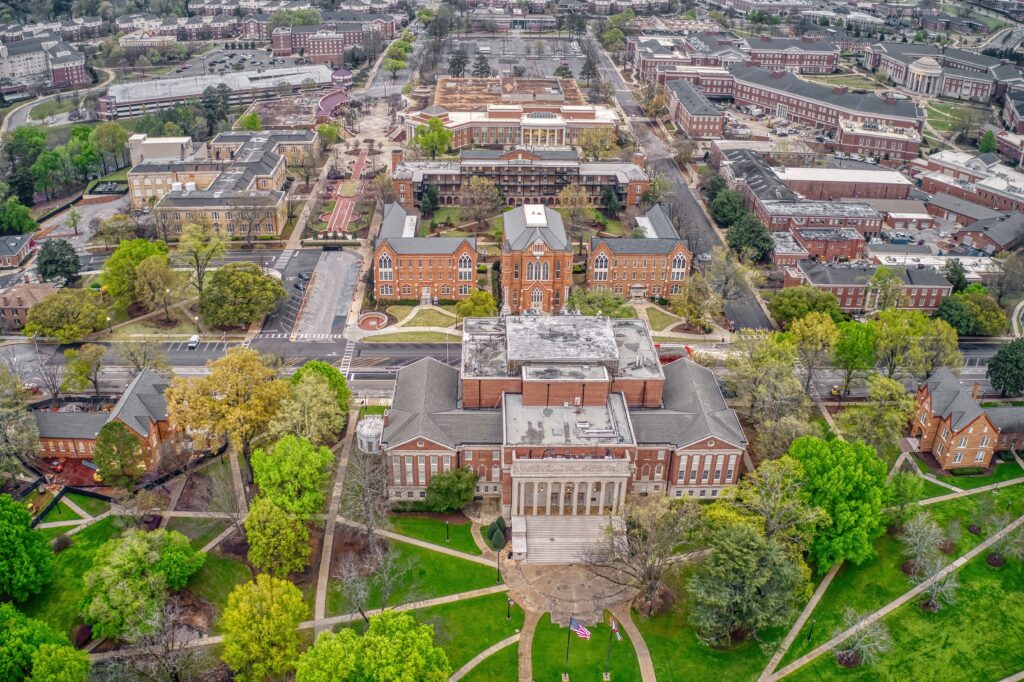
Tuscaloosa, home to the University of Alabama, is a city where academics, sports, and culture intertwine. Its most famous landmark is Bryant-Denny Stadium, where Crimson Tide football games draw more than 100,000 fans, creating an atmosphere that rivals any professional sporting event.
Beyond football, Tuscaloosa is rich in history. It served briefly as Alabama’s state capital in the early 19th century, and historic buildings still stand from that era.
The Paul W. Bryant Museum honors the legendary coach who helped build the university’s football dynasty. Cultural life thrives in the city, with theaters, galleries, and a lively downtown filled with music and dining.
The nearby Tuscaloosa Riverwalk offers a peaceful place to enjoy views of the Black Warrior River. Tuscaloosa balances its role as a college town with a broader identity as a cultural and historical hub.
Auburn
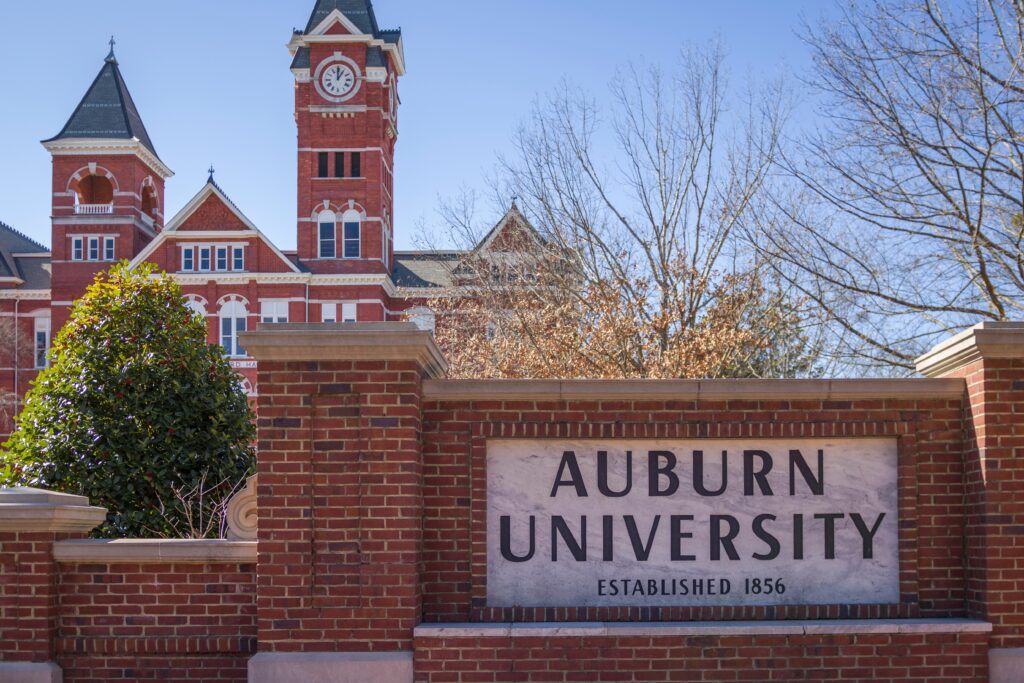
Like Tuscaloosa, Auburn is defined in part by its role as a university town, home to Auburn University. The school’s traditions, particularly the famous “War Eagle” battle cry, bring the community together, especially on football Saturdays when Jordan-Hare Stadium fills with roaring fans.
Auburn also offers cultural attractions like the Jule Collins Smith Museum of Fine Art, which houses works by American and European masters.
The city prides itself on its motto, “The Loveliest Village on the Plains,” a phrase borrowed from poet Oliver Goldsmith, and its tree-lined streets and vibrant downtown uphold that reputation. Just outside the city lies Chewacla State Park, a natural playground with hiking, mountain biking, and waterfalls.
Auburn blends the youthful energy of a college town with the charm of Southern hospitality, making it a lively and welcoming destination.
Monroeville

Known as the “Literary Capital of Alabama,” Monroeville is celebrated worldwide as the hometown of Harper Lee and Truman Capote. Harper Lee’s To Kill a Mockingbird immortalized the town under the fictional name of Maycomb, and today the legacy of that novel shapes the identity of Monroeville.
At its heart is the Monroe County Courthouse, whose courtroom inspired the pivotal scenes of Lee’s novel. Now a museum, it hosts annual stage productions of Mockingbird, drawing visitors from across the globe. Beyond literature, Monroeville is a charming Southern town, with a courthouse square lined by shops, cafés, and historic buildings.
The town embraces its cultural legacy through the Monroeville Literary Festival, which honors Alabama’s rich storytelling tradition. Walking the streets here feels like stepping into a living novel, where history, literature, and Southern charm are inseparably entwined.
Mooresville

Tiny but deeply historic, Mooresville is one of Alabama’s oldest towns, incorporated in 1818—before Alabama even became a state. With fewer than 60 residents, it feels like a living time capsule. Its streets are shaded by massive oaks, lined with historic white-frame houses and picket fences that seem untouched by modern life.
The Mooresville Post Office, established in 1840, is still in operation, making it the oldest working post office in Alabama.
The town has been meticulously preserved, offering a rare glimpse into 19th-century Southern life. Though small, Mooresville’s significance is enormous: it represents continuity, heritage, and the quiet endurance of community. It has even appeared in films and inspired countless artists and photographers who come here to capture its timeless beauty.
Eufaula
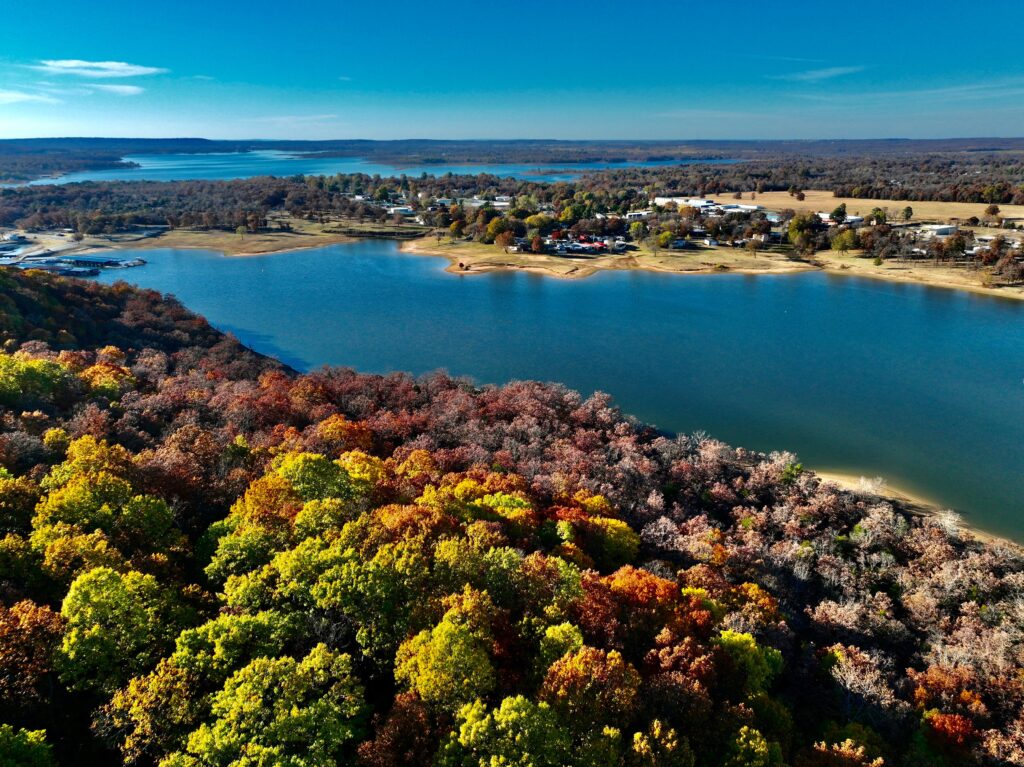
Set along the Chattahoochee River, Eufaula is renowned for its grand antebellum mansions and historic charm. The city hosts the annual Eufaula Pilgrimage, where residents open their historic homes to visitors, offering a rare chance to see the opulent interiors of these 19th-century treasures.
Strolling through Eufaula feels like entering the Old South, with tree-lined streets, wrought-iron balconies, and columned facades.
Beyond its architecture, Eufaula is also famous for Lake Eufaula, a sprawling reservoir often called the “Bass Fishing Capital of the World.” The combination of history and natural beauty makes the city unique: a place where one can tour stately mansions in the morning and cast a line into sparkling waters by afternoon. Eufaula’s blend of Southern grace and outdoor adventure ensures it stands among Alabama’s finest destinations.
Fairhope

On the eastern shore of Mobile Bay lies Fairhope, a town brimming with artistic spirit and natural beauty. Founded in 1894 as a utopian community, Fairhope has evolved into a cultural haven, attracting writers, artists, and dreamers. Its downtown is filled with art galleries, independent bookstores, and inviting cafés, while the Fairhope Pier extends into the bay, providing breathtaking sunsets.
The bluffs overlooking Mobile Bay offer panoramic views, and the town’s flower-filled streets exude charm. Fairhope also hosts literary workshops, art shows, and festivals that celebrate creativity. Its combination of natural scenery and intellectual vibrancy gives it a unique identity, drawing visitors who seek inspiration as much as relaxation. Fairhope embodies the very best of Alabama’s Gulf Coast charm: a community where art, nature, and a sense of belonging flourish together.
Bayou La Batre
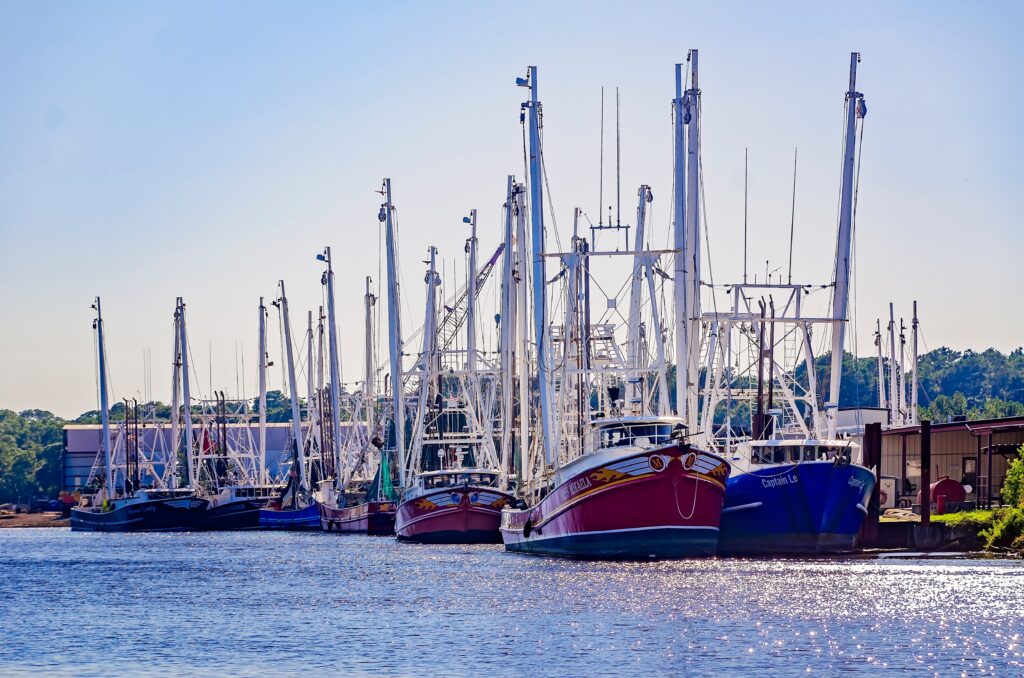
Known as Alabama’s seafood capital, Bayou La Batre is a working Gulf Coast fishing village where shrimp boats and shipyards define the skyline. The town’s economy revolves around the sea, with processing plants and docks bustling daily as fresh catches come ashore. Seafood lovers will find some of the freshest shrimp, oysters, and crab in the South. The town gained pop culture fame as the shrimping hub in the film Forrest Gump, but its authentic maritime culture runs much deeper.
Bayou La Batre also reflects Alabama’s cultural diversity, with communities of Vietnamese and Laotian immigrants who settled here and enriched its culinary and cultural life. It is not a polished tourist destination but a real, hardworking town where the Gulf defines both identity and livelihood. Visitors experience the Gulf Coast at its most authentic—raw, salty, and deeply tied to tradition.
Fort Morgan
Standing sentinel at the mouth of Mobile Bay, Fort Morgan is one of Alabama’s most important historic sites. Completed in 1834, it played a crucial role during the Battle of Mobile Bay in 1864, when Union Admiral David Farragut issued his famous order, “Damn the torpedoes, full speed ahead!”
The star-shaped brick fort remains remarkably preserved, with tunnels, barracks, and gun placements that bring history vividly to life. Visitors can explore the sprawling grounds, climb the ramparts for views of the Gulf, and imagine the roar of cannons that once echoed across the water.
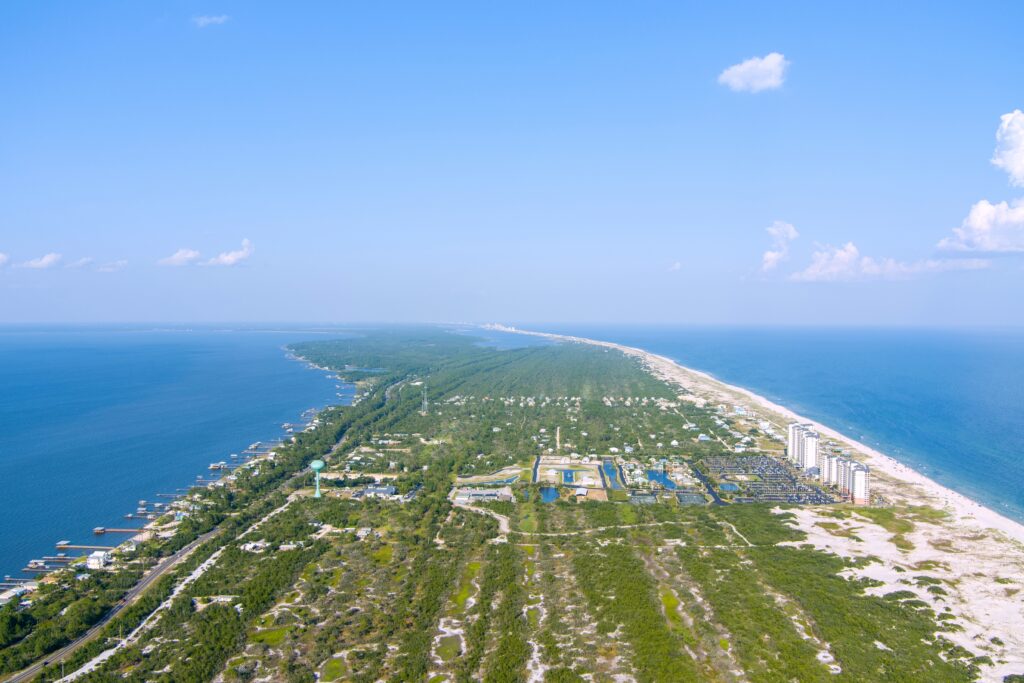
Today, Fort Morgan is also a site of natural beauty, surrounded by sandy beaches and bird habitats. It represents the intersection of military history and coastal landscape, reminding visitors of both the struggles and resilience that shaped the Gulf Coast.
Fort Gaines

Across the bay from Fort Morgan lies Fort Gaines, another pivotal stronghold in the Civil War. Built in the early 1800s, Fort Gaines guards the eastern entrance to Mobile Bay on Dauphin Island. Its massive brick walls, original cannons, and blacksmith shop give visitors an authentic sense of 19th-century military life. The fort’s role in the Battle of Mobile Bay complements Fort Morgan’s story, and together the two sites form one of the Gulf’s most significant historic landscapes.
Beyond history, Fort Gaines offers panoramic views of the Gulf of Mexico and the surrounding beaches. The combination of preserved military architecture and island setting makes it a place where the past and the natural world meet. Visitors leave with a sense of both the vulnerability and the resilience of the coastline during one of the most tumultuous periods in American history.
Moundville Archaeological Park

Located near Tuscaloosa, Moundville Archaeological Park is one of the most important Native American sites in the United States. Between 1000 and 1450 AD, this area was a thriving Mississippian culture city, home to thousands of people and the political and religious center of a vast region. Today, 29 large earthen mounds remain, arranged around a central plaza that hints at the scale and sophistication of the society that once flourished here.
The park’s Archaeological Museum houses artifacts such as pottery, tools, and ceremonial objects that reveal the spiritual and cultural life of the Mississippians. Walking through the park, visitors sense the power of this ancient community, which rivaled any pre-Columbian civilization in North America. Moundville is a reminder that Alabama’s history stretches back long before European settlement, rooted in indigenous cultures whose legacies endure.
Ave Maria Grotto
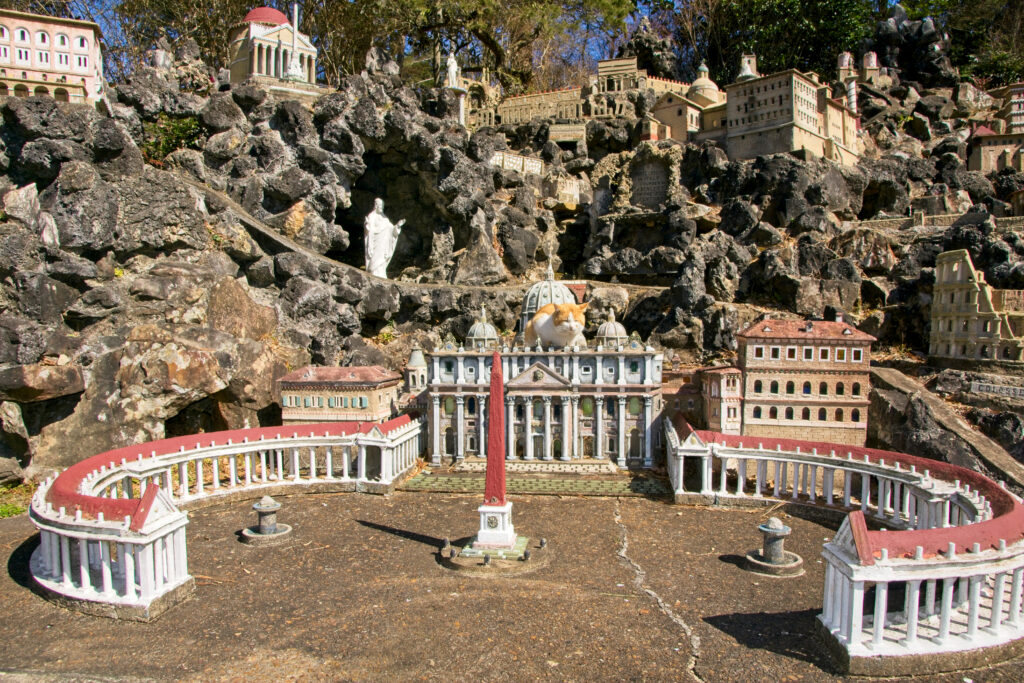
One of Alabama’s most unique attractions is the Ave Maria Grotto in Cullman, a four-acre park filled with miniature reproductions of famous religious buildings from around the world. Created by Brother Joseph Zoettl, a Benedictine monk at St. Bernard Abbey, the grotto features nearly 125 models, crafted over decades from stone, cement, and recycled materials. The collection includes replicas of St. Peter’s Basilica, the Alamo, and the Great Wall of China, each lovingly detailed.
Known as “Jerusalem in Miniature,” the grotto reflects Brother Joseph’s devotion and creativity, transforming simple materials into intricate works of art. The site is both whimsical and reverent, blending folk art with spiritual expression. It offers visitors an experience unlike any other in Alabama, where imagination, faith, and craftsmanship converge in a serene garden setting.
Birmingham Botanical Gardens & Zoo

In the heart of the “Magic City,” the Birmingham Botanical Gardens and Birmingham Zoo form two of Alabama’s most beloved cultural and natural spaces. The botanical gardens, spanning 67 acres, showcase more than 30 themed gardens, including a Japanese garden, rose garden, and conservatories filled with exotic plants. It is a peaceful retreat in the city, where visitors can stroll through seasonal blooms and learn about horticulture.
Just across the street, the Birmingham Zoo brings together wildlife from around the world, housing over 700 animals and engaging in conservation efforts. Together, the gardens and zoo create a family-friendly destination that balances education with enjoyment. They highlight Birmingham’s transformation into a city that values culture, science, and the natural world as much as its historic legacy.
Monte Sano State Park
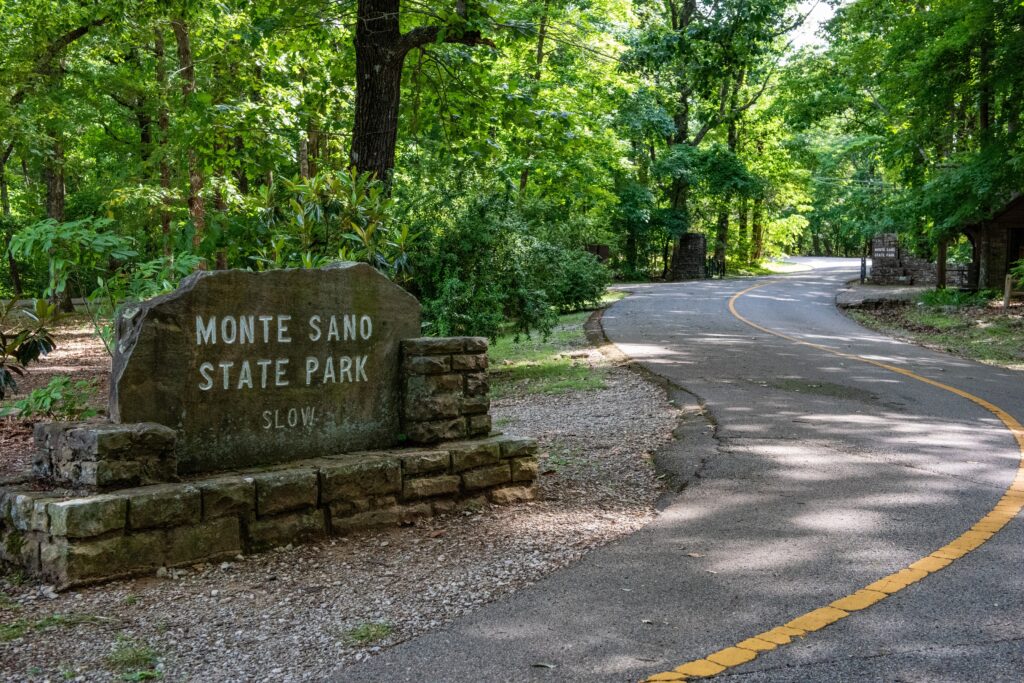
Perched above Huntsville, Monte Sano State Park has been a retreat for centuries—its name means “Mountain of Health” in Spanish, a nod to its 19th-century reputation as a health resort. Today, the park offers more than 20 miles of hiking and biking trails that wind through forests, wildflower meadows, and rocky overlooks.
Cabins built by the Civilian Conservation Corps in the 1930s still welcome visitors, adding a rustic charm to the park. Monte Sano is also beloved for stargazing; its nearby observatory hosts events for astronomy enthusiasts. Just minutes from the bustle of Huntsville, the park feels worlds away, offering tranquility, natural beauty, and a glimpse into both Alabama’s ecological and cultural history.
Wetumpka
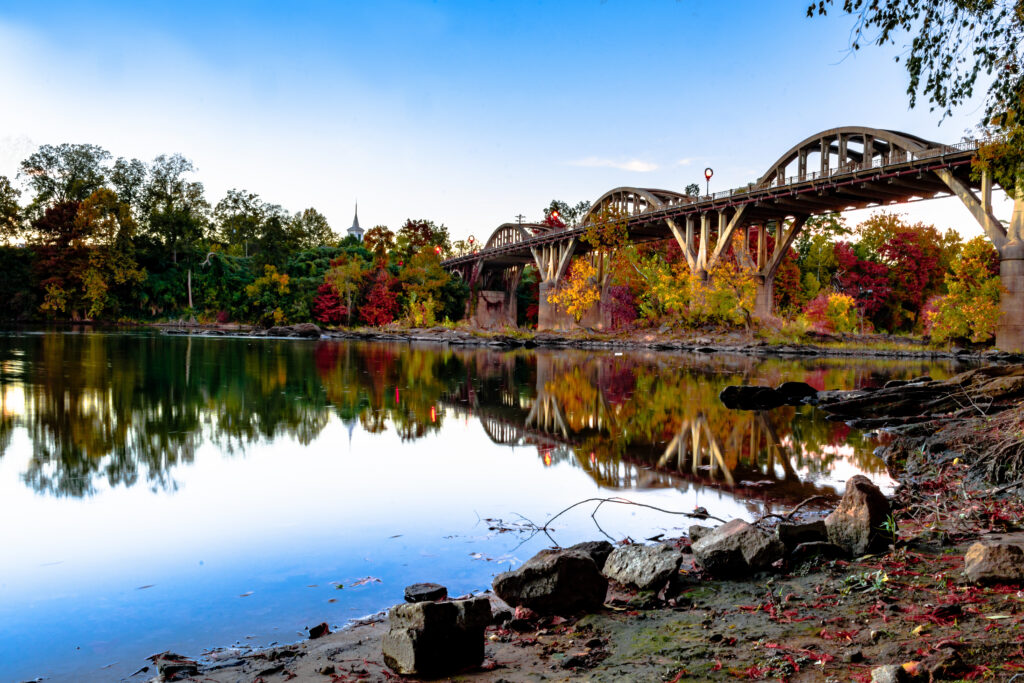
Known as the “City of Natural Beauty,” Wetumpka sits on the banks of the Coosa River and is distinguished by its dramatic landscapes. The town is located within the impact crater of a meteor that struck 85 million years ago, one of the most visible impact sites in the U.S.
The Coosa River cuts through rocky bluffs, offering opportunities for kayaking and whitewater rafting.
Wetumpka’s historic downtown has been revitalized with shops, restaurants, and murals, gaining national attention after being featured on HGTV’s Home Town Takeover. The town blends small-town charm with geological wonder, making it an unexpected highlight in Alabama’s heartland.
Decatur
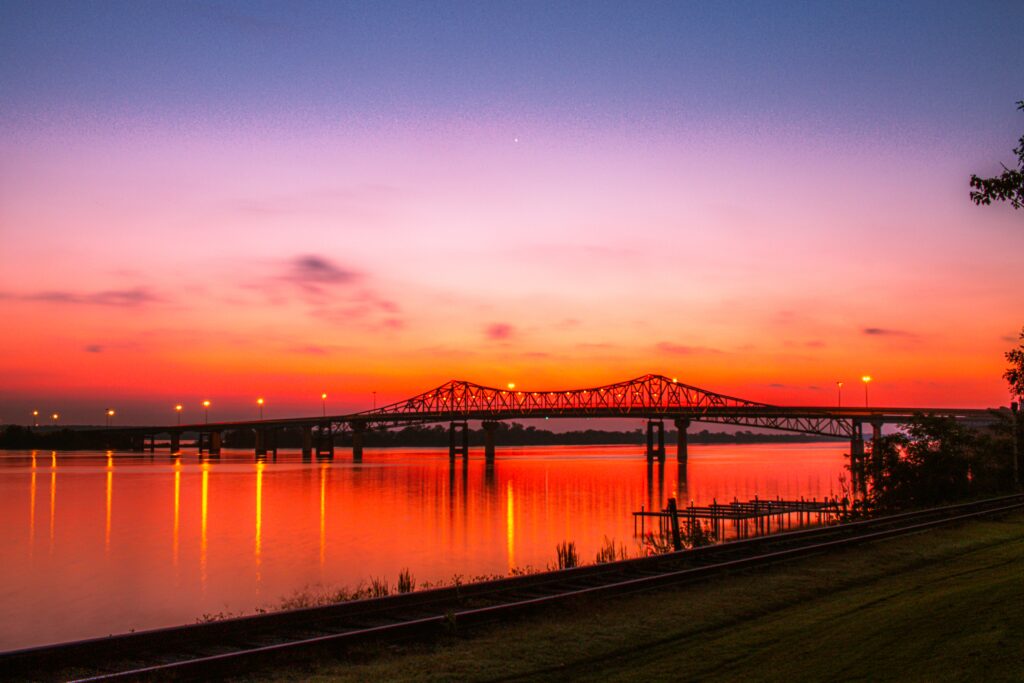
Situated along the Tennessee River, Decatur has long been an important river town. Today, it is known for its festivals, such as the Alabama Jubilee Hot Air Balloon Classic, which fills the skies with color every Memorial Day weekend.
The Cook Museum of Natural Science, one of the South’s finest, engages visitors with interactive exhibits on ecosystems, fossils, and live animals.
Decatur also preserves its history in the Old State Bank, a Greek Revival building that survived the Civil War. With its mix of science, history, and Southern hospitality, Decatur offers a rich cultural experience set against the backdrop of Alabama’s river landscapes.
Gadsden
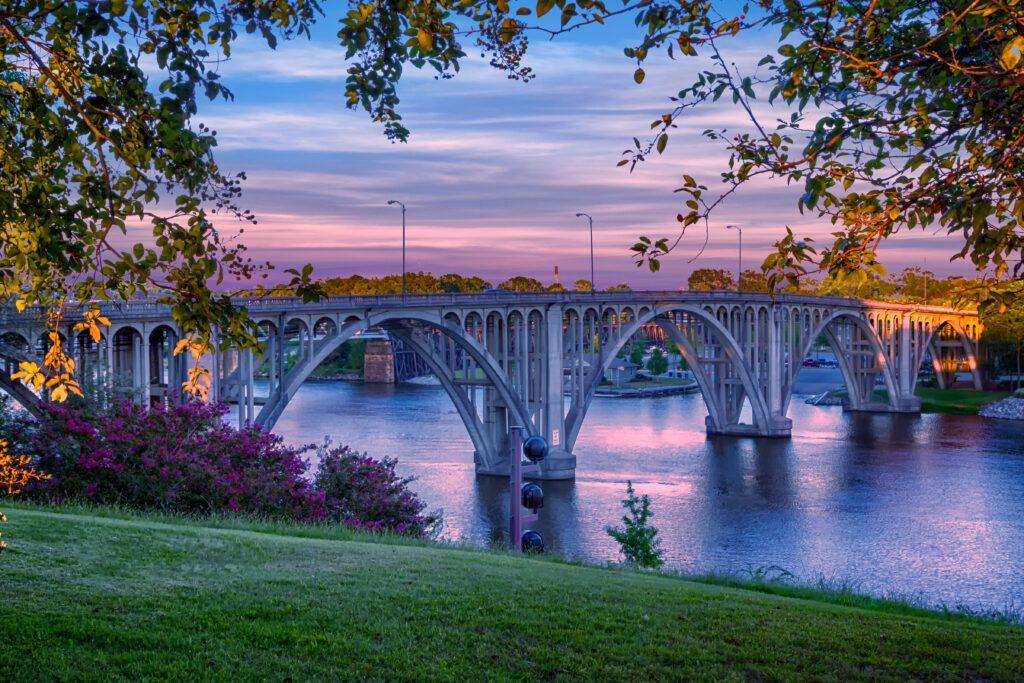
Nestled along the Coosa River, Gadsden is best known for its natural landmark, Noccalula Falls, though its downtown and cultural scene also deserve recognition. The falls are complemented by the city’s parks and riverfront, offering outdoor activities such as boating and hiking.
Gadsden’s art scene is anchored by the Mary G. Hardin Center for Cultural Arts, which hosts exhibits, performances, and community events.
The city also features antique shops and local restaurants that reflect its regional character. With its balance of nature and culture, Gadsden represents the best of a mid-sized Alabama city—rich in history, surrounded by beauty, and brimming with community pride.
Clanton

In the heart of Alabama, Clanton is synonymous with one thing: peaches. The town is the center of Alabama’s peach industry, and its towering peach-shaped water tower makes the association unmistakable.
Visitors flock here during peach season to sample fresh fruit, pies, and preserves, with the annual Chilton County Peach Festival celebrating the harvest each summer.
Beyond peaches, Clanton offers small-town Southern charm, with local shops and historic churches anchoring the community. For travelers passing through central Alabama, it is both a sweet stop and a proud symbol of the state’s agricultural traditions.

